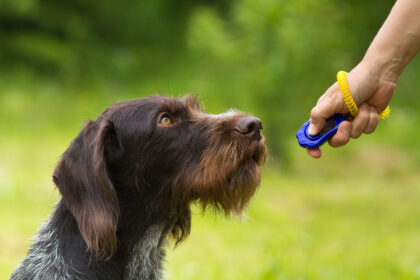 For many people, a dog is a faithful companion in all situations of life. However, in order for your dog to really accompany you all the time, it first needs solid training. In order to ensure obedience in all situations, there are many different training methods, so that everyone can find the right method for themselves and their dog. Among experts, clicker training is particularly popular as a gentle and versatile reward-based method. We explain what clicker training is, how it works and how you can use it!
For many people, a dog is a faithful companion in all situations of life. However, in order for your dog to really accompany you all the time, it first needs solid training. In order to ensure obedience in all situations, there are many different training methods, so that everyone can find the right method for themselves and their dog. Among experts, clicker training is particularly popular as a gentle and versatile reward-based method. We explain what clicker training is, how it works and how you can use it!
What is a clicker?
The basis of clicker training is the so-called clicker. Its core piece is a bent piece of metal that makes a clicking sound when pressed. To make it easier to use, this piece of metal is mounted in a holder that varies in shape and design.
The sound produced by the clicker is used to reinforce desired behaviour – however, in order for this to really work, the dog must first be introduced to the clicker before starting clicker training.
How does clicker training work fro dogs?
Clicker training works according to the principle of conditioning. This is based on the assumption that a stimulus leads to a consequence – for example, when your dog hears you opening the food bin, he knows that the consequence will be food. Even if you don’t feed your dog – just the sound of opening the bin will make his mouth water.
If you always ring a bell before opening the bin, the ringing will soon have the same effect as the sound of the bin – your dog’s stomach will growl. This special case, in which an artificially created stimulus replaces the actual stimulus, is called operant conditioning.
For operant conditioning, the sound of the clicker is first given a positive stimulus by giving a reward (e.g. a treat) directly in response to the click. In this way the dog quickly learns that the clicker is something pleasant, or that the clicker is followed by something pleasant. In this way, the clicker can be used later in training as a “bridge” until the actual reward is given – it is, so to speak, the promise that a reward will follow.
This makes sense because dogs only have a very short period of time in which they can recognise connections between behaviour and consequences. Researchers assume that connections can even only be made if the consequence occurs within just one second. This makes the right timing in training all the more important: if the reward is given too late, the dog can no longer associate you with the behaviour it was meant to reward – the reward loses its meaning.
The clicker, on the other hand, can be used at the exact moment when the desired behaviour is shown – the sound shows the dog that there is a behaviour worth rewarding. After all, that is exactly what the clicker does: announce a reward. The moment until the reward is actually given is bridged by announcing the reward with the click sound – optimal timing becomes possible.
Trial and error and the command of the word
First of all, clicker training does not require many words: The dog does something and the clicker clicks – or not. If your four-legged friend is well conditioned to the clicker, he will probably try out different behaviours to find out what makes the clicker (i.e. the reward promise) sound. Your dog will probably learn quickly and repeat the desired behaviour – after all, there is a reward waiting! Now is the right time to take the next step.
When your four-legged friend has understood which behaviour is the desired one, you should give the word command for it. At first, the word command is given directly to the click and the desired behaviour, then the command is moved forward bit by bit. Very soon the dog will react to the word command, because after all he wants to get his reward quickly.
Of course, you can also learn complicated, multi-step exercises in this way: Even the beginning of a desired behaviour may be “clicked”.
Why clicker?
One of the advantages of clickers is clearly the better timing: as already explained, the click signal makes it much easier to reward the moment when the desired behaviour is shown. But this is by far not the only positive aspect of this training method.
The typical click of the clicker is a sound that does not occur in normal everyday life – this makes it distinctive and stands out clearly from ambient noise. This makes it a clear signal that cannot be confused.
The “click” is also easily perceivable over longer distances – so the dog can be rewarded even if it is clearly out of your reach. The fact that the actual reward follows later is not a problem for the dog, because for him it is the moment of the click that counts.
In addition, the click always remains the same. It doesn’t matter whether you as the owner are annoyed, angry, bored, sniffy or otherwise emotionally or health impaired: The signal remains constant. This prevents the training success from being hindered by your current emotional state or a cold from undermining your position.
Criticism of the concept
But despite all the positive aspects, clicker training is of course not beyond reproach. A common criticism is that the clicker must be a constant companion for successful training. However, we can reassure you that outside of the “training sessions” you can lead your dog as usual without the clicker – even though it must be admitted that many people who have acquired a taste for clicker training no longer want to do without it.
A serious argument is that clicker training, as a purely positive method, works exclusively with positive reinforcement. This is optimal for training new behaviours – but it is not optimal for training away existing misbehaviour. For example, if the dog digs holes in your beautiful lawn, it may be possible to teach him that he will be rewarded when he stops – but not that he will not start again. Therefore, punitive behaviour is called for here and in similar situations, for example by scolding, splashing water or the like. In addition to this, however, clicking makes sense again: because only if you offer your dog an alternative action will the punishment have a long-term effect and the undesired behaviour can be permanently extinguished.
Another point of criticism is that some dogs are so enthusiastic about clicker training that they know no stopping: The motivation is so high that they constantly try to get their owner to click – be it by barking, nibbling, barking at or other unwanted behaviour. You can avoid this behaviour if you teach your dog an appropriate signal for the beginning and end of clicker training in good time (for example, word signals such as “action/end”).
When can clicker training be used?
Clicker training is used in many ways: in animal gardens and zoos, with dogs, cats, horses, budgies – in other words: everywhere! Of course, intelligent animals show faster training successes, but basically no animal is too old, too stupid or even too stubborn for clicker training. Especially with seemingly “education-resistant” animals, this training method can deliver great results, because what we humans perceive as stubborn is often in reality a pronounced tendency to want to solve problems themselves and to act independently of the owner’s commands. Clicking, on the other hand, initially does without commands: The dog learns by trial and error which behaviour is rewarded and which is not. Clicking is therefore particularly suitable for animals that think for themselves and like to solve problems.
Once the clicker has been introduced appropriately, it can be used for learning basic obedience, as well as for small tricks, or for occupation and mental work.
Admittedly: Clicker training is not a panacea. But it can motivate your dog and improve the cooperation between you and your dog. If you feel like it, why not give it a try? You will be amazed at how much fun it is.

Every day we experience the wonders of nature with our dogs. This inspiration is the basis for our lives and our products. In our magazine we share with you our passion for these wonderful animals. Visit our socials and become part of the DOG FIT community.


Leave a Reply